
Sense's Reminiscences
by Sense de Jong
- Geurt
- Tante Betje (by Sense)
- Tante Betje (by Truus)
- Miss Roozendaal
- Concert in Winschoten
- A baptism remembered
- My birdhouse
- War veterans
- Henk Smit - bass/baritone
- Stefan
- In memory of Herman - I
- In memory of Herman -II
- Remembering AK
- Our love for music
- Herman - Promoter of Christian Causes
- A Salem evening with Herman de Jong
- From Elsinore to Monschau
- A Danish Treat
- Glimpses of Thuringia and Saxony
- Domie and Hansie
- La Manche, Newfoundland
- Bermuda - Isle in the Sun
- 1932 and 1934
- 1940 - 1945
- Winschoten, Grace on the Venne
- 1948
- Johann Sebastian Bach
- From Generation to Generation
- Seven children and a harmonium
- K.P. - A Man of Enterprise
- Cuba and the tragedy of the MS St Louis
- It all began in Norwich, Ontario
Another site by Sense de Jong:
~ Hinne de Jong ~
A Chronicle
Sites by Henry de Jong:
~ Herman de Jong ~
Memorial
~ Newmaker Notes~
Writings, Pictures, Collections
~ AACS/ICS Niagara Conferences~
1970 - 1991
It's the spring of 2008. Once more, Corrie and I were passengers on an OAD excursion bus. Early in the morning of June 2, 2008, a typical yellow OAD bus had picked us up at the "Buikslotermeerplein" in Amsterdam, a well-known pick-up point for that area of the Netherlands.
We did the "Beek" thing (see the previous story) and after coffee etc. we were off on our bus destined for Thuringia and Saxony in Germany. Soon we entered the highly-industrialized area of the Ruhr. Going almost straight east, we passed cities like Essen, Bochum, Dortmund, Soest, Kassel, arriving at our hotel in Eisenach later that day. Just before Eisenach we crossed the line that was once the border between West and East Germany.
Eisenach
Eisenach, birthplace of Johann Sebastian Bach, suffered major damage during World War II. Under Communist rule little was spent on upkeep and many historical buildings were torn down. Today, after years of restoration, Eisenach is again worth a visit.
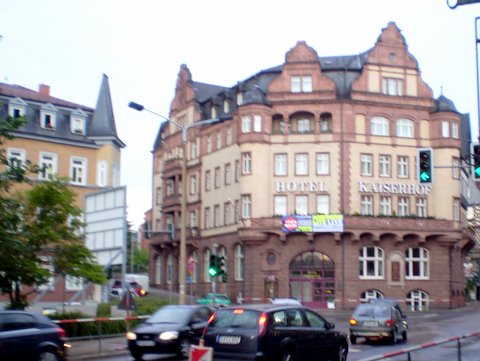
"Hotel Kaiserhof" - our refuge in Eisenach
Approaching Eisenach, our bus driver - who turned out to be an excellent guide - alerted us to the "Wartburg Castle" high upon a hill. Once we settled into our hotel, the bus driver took us there. We climbed some 250 steps to the top of the hill to tour this famous place, once home to Martin Luther the Reformer.
During the Wartburg tour the weather deteriorated and dark, threatening clouds promised a major downpour. A vicious electrical storm soon engulfed the castle. Scary!
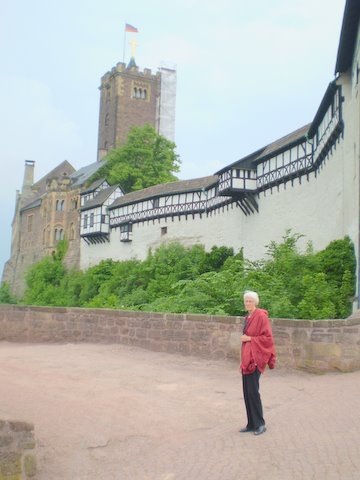
Corrie in front of Wartburg Castle
Martin Luther must have experienced these kind of storms many a time. In 1521, Luther was excommunicated by the Pope and outlawed by the Emperor. He sought refuge in the "bailiff's lodge" at the Wartburg. During the time of his custody, he lived and worked in a sparsely furnished room, today known as the "Lutherstube." At the urging of his friend Melanchton, Luther translated the New Testament from the original Greek text into German. He completed that project in 10 weeks!
We entered the "Lutherstube" and it felt like old Martin might walk in any minute. It's centuries old. It is said that Luther, in a fit of rage at the devil, picked up an inkpot and smashed it against a wooden wall. People have picked at this spot, trying to take home a souvenir. But the spot is still there!
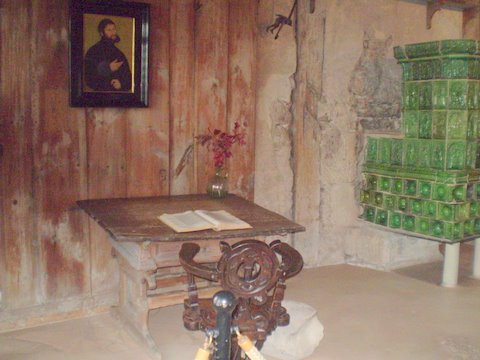
The "Luther Stube" - Martin Luther's work place.
To stay in the place where Bach was born, to visit the site of the "Bach Haus" (now a museum) and to walk around the magnificent "Georgenkirche" (Church of St. George) where he was baptized was a special experience for us.
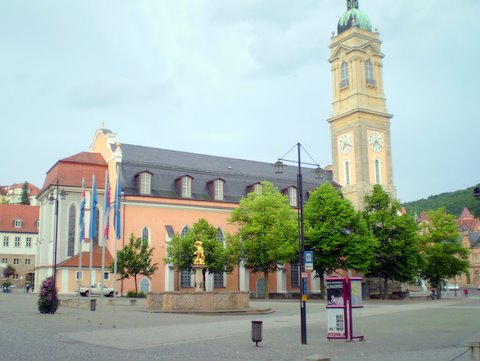
Church of St. George (J.S. Bach was baptized here)
Leaving for Weimar
Maria Barbara was Bach's first wife, as well as his second cousin. They were married in Dornheim, a village close to Arnstadt, which we saw from the bus as we drove by. We would have loved to explore that little town. Johann Sebastian and Maria Barbara had seven children, but only four survived to adulthood.
We did stop at Rhula's "Mini-a-Thur" - the German version of "Madurodam" close to The Hague. All the important architectural buildings in Thuringia were represented here in miniature form, including Eisenach's "Georgenkirche." This is also the place where we got better acquainted with fellow-passengers Vera and Henk, who hailed from Overijssel, a province in the Netherlands. As fellow believers, we had long talks together sharing our faith in Jesus Christ, Who is the source of our strength in good and bad times.
On this day we arrived in Weimar, the city of Goethe, Schiller and Bach. Bach lived and worked here. Employed at the ducal court in Weimar as organist and chamber musician, he wrote some thirty of his numerous cantatas here. He also completed the bulk of his organ works, including the "Orgelbuechlein" and the first and last of his Brandenburg concerti.
Heavily damaged during World War II, the notorious East German Headquarters of the Gestapo still stands there today. As we wandered around the restored city centre, looking at buildings that looked old - but were not - Corrie and I couldn't help but obey the voice in us: find a thrift store!
Buchenwald
We didn't have to go to the notorious "Konzentrationslager Buchenwald." We were not even aware that this former Nazi concentration camp was so close to the city of Weimar. Our bus driver simply left it up to us and a number of people immediately opted to go shopping. But most of us decided to come along with our driver/guide. Corrie and I, as well as Vera and Henk, simply wanted to honour those who had suffered and died there.
Once we had left the affluent suburbs of Weimar we entered a wooded area. The bus began to bounce up and down in a strange manner. Our driver told us that we were on the "Etterburger Strasze," a road left unchanged since the Nazi era. Referred to as the "Blut Strasze" (Blood Street), it was constructed in 1939 by inmates of the already then existing camp. Obviously, the road was built with pieces of rock broken by the prisoners. Running parallel along the road we could see the old railroad track leading to the camp ahead. And soon we saw a clearing in the woods: remnants of a station platform. It shocked us, because this place was so similar to the pictures we had seen of how whole trainloads of people were unloaded at the platforms outside such death camps as Dachau, Auschwitz, Sobibor, etc. This had happened here...just a few kilometres from the civilized city of Weimar.
Buchenwald Concentration Camp, according to a museum brochure I received, was built in 1937. It was intended for political opponents of the Nazi regime: criminals, so-called "a-socials," Jews, Jehova's Witnesses, gypsies, homosexuals and Russian POWs. The inmates were ruthlessly exploited in armament factories located in Buchenwald and its many sub-camps. Prisoners were killed, or starved to death, on a mass scale, and many died as a result of medical experiments and the despotism of the SS "Schutzstaffel" ( security police).
Shortly before liberation, the SS attempted to evacuate Buchenwald and sent 28,000 inmates on death marches. Some 21,000 remained in the camp. On April 11, 1945, members of the Armored Division of General Patton's Third U.S. Army arrived at the gatehouse. They found that a group of Communist inmates had already "liberated" the camp. They set the clock above the gatehouse at 3:15 p.m., the precise moment of the Communist take-over. And this is what the clock reads today as a permanent reminder to all who come to visit.
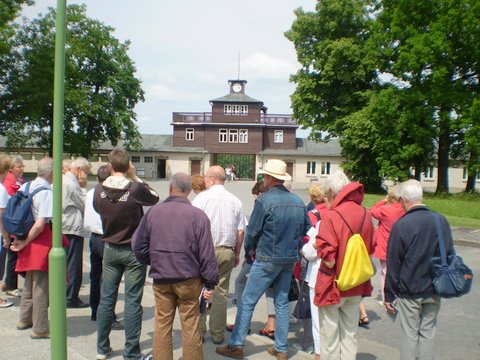
Buchenwald's camp gate
Corrie, Vera, Henk and I silently walked through the camp gate. The inscription on the gate reads "Jedem das Seine" which could be translated as "To Each His Own" but it is really meant to say "Everyone Gets What He Deserves."
Once through the gate I was soon standing on the vast "Appell Platz" and it hit me that nothing grew here and not a bird was to be seen or heard. The whole place had a satanic feel about it. I realized that this was the site where the inmates were ordered to stand for endless roll calls, in all kinds of weather. Looking around I saw the building housing the maximum security cells, and, outside the perimeter fence, the cages where the guard dogs were kept and the homes where the SS thugs lived.
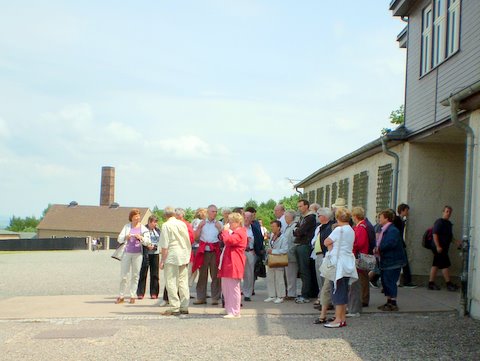
"Appell Platz" (roll call area). The building in the back houses the execution rooms and the crematorium.
To the right sat the crematorium and other unmentionable places. We were told that thousands of prisoners had to enter a fake infirmary and place themselves under a height gauge. An SS man stood behind the wall and observed the prisoner through a slit. He then adjusted the gauge and gave the prisoner a neck shot. The noise of the gun was masked by a radio set at maximum volume to divert the next victim's attention. One Buchenwald survivor estimates that 8483 Soviet POWs were shot in that manner!
The first commandant of the Buchenwald Camp was Karl Koch, a sadistic SS officer. His wife, Ilse Koch, was an even worse satanic figure. She became known as "The Bitch of Buchenwald." If you wish, "google" her name and read more on the internet.
Our bus driver/guide pointed something out to us. He said that just outside the electric, barbed wire fence - across from the crematorium - SS officers had ordered the inmates to build a zoo intended for the children of the Nazi families living close by. It still sits there today.
Outside Buchenwald stands an enormous "Mahnmal Memorial and Clock Tower," which we briefly visited. It can be seen for miles around. This memorial is meant as a warning to all future generations.
We saw other memorials both inside and outside the gate. One of them is an exposed basement detention cell near a stone quarry. Dietrich Bonhoeffer and members of the July 20, 1944, conspiracy against Hitler were held prisoner here before their execution in Flossenburg in 1945.
From 1937 to 1945 altogether 250,000 people were imprisoned in Buchenwald. More than 50,000 of them lost their lives there.
Excursion into the Czech Republic
Leaving the Weimar area we headed that evening to the village of Hartmannsdorf where we stayed at a modern, western-style hotel. That was a surprise because we were now deep into former Communist East Germany. Hartmannsdorf is close to the large city of Chemnitz which in the Soviet era was called Karl Marx Stadt.
From this pleasant hotel in the country, we drove to the beautiful city of Annaberg-Buchholz located close to the Czech border. Here we relaxed, talked over coffee, and admired the impressive architecture.
Our bus driver warned us before we drove into the village of Jachymov, just south of the Czech border. We had seen the effect of Soviet administration in Chemnitz. Even more than Chemnitz, this village showed signs of severe mismanagement and lack of infrastructure spending. The place was falling apart. Crippling poverty was all around us. Our bus driver/guide told us prostitution was rampart. He said: "Here the women are trying to remain standing by lying down" (free translation from the Dutch).
Our goal that day was the city of Karlovy Vary (also known as Karlsbad) which is a spa city in western Bohemia, about 130 km. west of Prague. In the 19th century it became a popular tourist destination, especially for Europe's wealthy invalids. The surrounding area was once subject to volcanic activity which accounts for the thermal springs. The best known is the "Sprudel" which gushes hot water to a height of 37 feet.
When we arrived at this almost unreal place of wealth, we saw one of the world's largest hotels, called the "Grand Hotel Pupp." The James Bond film "Casino Royale" was partially shot here. Ah, for us we had found a place where we could obey the call of nature. So, we just sauntered inside.
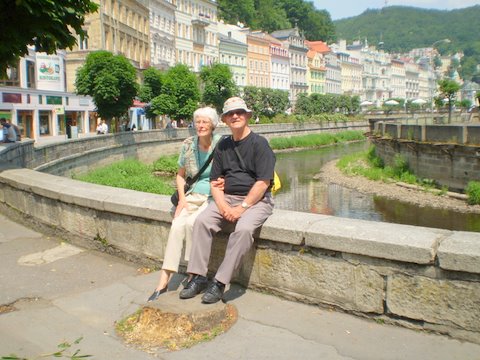
Taking a break in Karlovy Vary
We looked around us and saw a whole downtown with glittering shops, hotels, churches and health spas. The contrast between what we had seen in Jachymov and this fabulously wealthy place was hard to accept. Yet, behind this facade of wealth and the feel of fakeness - if not snootiness - we discovered the dilapidation of the back streets of Karlovy Vary. A sad place.
In 1938, the Sudetenland, including Karlsbad, became part of Nazi Germany after the Munich Agreement. After WW II, the majority of the ethnic German population was expelled in accordance with the Potsdam Agreement. The Russians moved in....
Since the fall of the Soviet Union and the end of Communist rule in the Czech Republic there has been a steady increase of the Russian business presence in Karlovy Vary.
It may draw endless numbers of tourists every year, but we never felt safe there that day and were glad to be on our way again.
Dresden on the Elbe River
Geert Mak, a well-known Dutch author, in his massive book Europa described his European wanderings. His description of the city of Dresden rang true to us. Nearly the entire city was wiped out by Anglo-American Air Forces during the controversial raids early in 1945. The "why" is still being debated today. Maybe the Allied higher- ups did not want this cultural city to fall into the hands of the Soviets.
The February 1945 bombing took place just 12 weeks before the Wehrmacht of Nazi Germany surrendered. In four raids, 1300 heavy bombers dropped nearly 4000 tons of high-explosive bombs and incendiary devices on this city, the baroque capital of the German State of Saxony. The resulting firestorm destroyed 34 square kilometres of the city centre. There were between 24,000 and 40,000 civilian casualties (but the exact figure is still a point of much controversy).
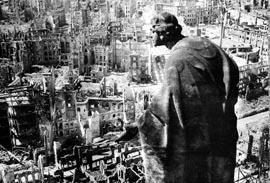
Dresden in the
spring of 1945....
After years of Soviet neglect, the people started rebuilding. What you see today - as Geert Mak wrote - is a somewhat weird collection of squares and streets with many made-to-look-old buildings. During our wanderings, I lost Corrie for a while. I found her back in a large glitzy mall not that much different from what you find in Canada and the U.S.A.
The "Altstadt" (old city) is no more. In fact, the firestorm caused by the carpet bombing of February 13-15, 1945, obliterated nearly everything, including the Old City Hall, built in 1745, the Frauenkirche (Church of our Lady), and the famous Zwinger Palace.
The Zwinger's "Gemaldegalerie Alte Meister" (Old Masters Picture Gallery) held some 3000 works by Raphael, Titian, Rembrandt, van Ruysdael, Rubens, van Dijck and others. These works of art had been evacuated but fell into Russian hands in 1945 and disappeared behind the Iron Curtain.
In Dresden we were introduced to Bart, our Dutch-speaking guide, who owns a restaurant close to the downtown area. He took us to the square where we gazed upon the now-restored Frauenkirche, a Lutheran church. Bart told us that not one bomb ever hit the church during the terrible bombing. But the resulting firestorm caused the church to implode. The pile of blackened stones were never cleared. The stones would lie in wait in a pile in the centre of the city for the next 45 years (!) as Communist rule enveloped East Germany.
This heap of stones was conserved as a war memorial within the inner city of Dresden as a direct counterpart to the ruins of Coventry Cathedral, which was destroyed by German bombing in 1940 and also seen as a war memorial in England.
The story of the Frauenkirche's re-construction is worth a story by itself. One can read about it on the internet. It has now been reconstructed as a landmark symbol of reconciliation between former warring enemies. Reconstruction of the exterior was completed in 2004, it's exterior in 2005. After 13 years of painstaking work, the church was re-consecrated on October 30, 2005
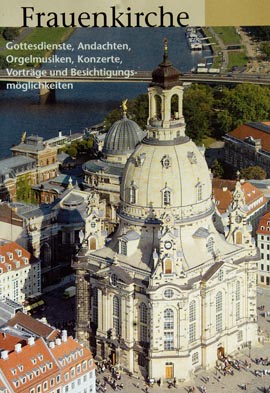
Dresden's restored "Frauenkirche."
We looked in wonder at the "Church of our Lady." As we entered the ornate church itself we noticed that a service was in progress. We were not allowed to take pictures. We then walked deeper into the city and stopped at the "Kreuzkirche" (Church of the Cross). Again, we saw the posters announcing organ concerts featuring organists playing Johann Sebastian Bach. I now deeply regret that I never once heard one of those organs being played.
In front of the "Kreuzkirche", at a huge construction site, we saw the cavities in the ground, the thick walls of age-old cellars and the unmistakable signs of immense destruction and fire. It happened 63 years ago....
Later, Corrie, Vera, Henk and I boarded one of the many sightseeing boats called "Schaufelrad Dampfschiffe" (steam-driven paddlewheeler) and made a quiet tour on the very shallow river Elbe. From there we saw the contours of the city of Dresden. After all the restoration that took place, the city again looks impressive.

On the way back to the Netherlands, the driver stopped the bus for a while. We got off to stretch our legs. In front of us were the remnants of what was once called the "Iron Curtain," a high steel fence disappearing from the road into the woods. This was once the heavily-patrolled border between East and West Germany.
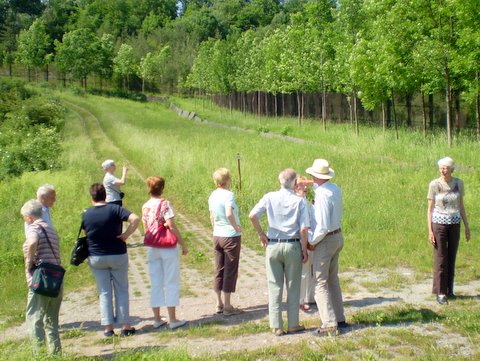
Remnants of the "Iron Curtain" somewhere on the former East/West German border.
In a nearby field poppies, in full bloom, were quietly displaying their beauty in praise of "God the Father, Almighty, Maker of heaven and earth."
(Note: I'm indebted to the "Wikipedia, the free encyclopedia" website and other sites for many of the details included in the various stories above - sdj).
[an error occurred while processing this directive]